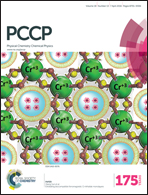Adsorption energy of small molecules on core–shell Fe@Au nanoparticles: tuning by shell thickness
Abstract
The adsorption of several small molecules on different gold surfaces, Au(001), strained Au(001) and Au(001) epitaxied on Fe(001), has been characterized using density functional theory. The surface strain leads to a less energetically favourable adsorption for all studied molecules. Moreover, the presence of the iron substrate induces an additional decrease of the binding energy, for 1 and 2 Au monolayers. For carbon monoxide (CO), the structural and energetic variations with the number of Au monolayers deposited on Fe have been analyzed and correlated with the distance between the carbon atom and the gold surface. The effect of the subsurface layer has been evidenced for 1 and 2 monolayers. The other molecules show different quantitative behavior depending on the type of their interaction with the gold surface. However, the iron substrate weakens the interaction, either for the chemisorbed species or for the physisorbed species. 2 Au monolayers seem to be the best compromise to decrease the reactivity of the gold surface towards adsorption while preventing the Fe oxidation.


 Please wait while we load your content...
Please wait while we load your content...